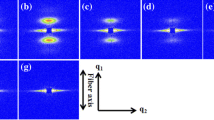Abstract
The effect of drawing and annealing treatments on the α transition in poly(ethylene terephthalate), PET, yarns has been studied using a combination of X-ray and dynamic mechanical techniques. It was found that drawn, crystalline PET yarns exhibit a shift in the position of the α transition to lower temperatures for high annealing temperatures; this effect has been observed for unoriented, crystalline PET. The main difference between the results for the drawn and unoriented yarns lies in the position of the α transition on the temperature scale; the α transition occurs at higher temperatures the higher the draw ratio. The shift in the position of the α transition with anealing is interpreted in terms of the number of crystals whilst the change in position of the α transition brought about by drawing is explained by orientation in the amorphous regions.
Zusammenfassung
Der Einfluß von Verstreckung und Temperaturbehandlung auf den α-Übergang in Poly(äthylenterephthalat), PET, Garn wurde untersucht unter Anwendung von Röntgen- und dynamisch-mechanischen Methoden. Es wurde gefunden, daß für hohe Vergütungstemperaturen verstreckte, kristalline PET-Garne eine Verschiebung des α-Überganges zu niedrigeren Temperaturen aufweisen, ähnlich wie für nicht verstrecktes, kristallines PET. Der Hauptunterschied zwischen verstreckten und nicht verstreckten Garnen ist die Lage des α-Überganges auf der Temperaturskala; der α-Übergang liegt für höhere Verstreckung bei höheren Temperaturen. Die Verlagerung des α-Überganges durch Temperaturbehandlung wird auf die Anzahl der Kristallite zurückgeführt, während seine Verschiebung durch Verstreckung erklärt wird durch die Orientierung in den amorphen Bezirken.
Similar content being viewed by others
References
Thompson, A. B. andD. W. Woods, Trans. Faraday Soc.52, 1383 (1956).
Takayanagi, M., M. Yashino, andS. Minami, J. Pol. Sci.61, 171 (1962).
Kawaguchi, T., J. Pol. Sci.32, 417 (1958).
Illers, K. H. andH. Breuer, J. Colloid. Sci.18, 1 (1963).
Dumbleton, J. H. andT. Murayama, Kolloid-Z. u. Z. Polymere220, 41 (1967).
Dumbleton, J. H., J. P. Bell, andT. Murayama, J. Appl. Polym. Sci., in press.
Takayanagi, M., Mem. Fac. Engng. Kyushu U.23, (1963).
Dumbleton, J. H. andB. B. Bowles, J. Pol. Sci.4, 951 (1966).
Tsvankin, D., Ya. Pol. Sci. USSR6, 2304–2310 (1964).
Klug, H. P. andL. E. Alexander, X-ray Diffraction Procedures (London 1954).
Dumbleton, J. H., J. Pol. Sci., in press.
Newman, S. andW. P. Cox, J. Pol. Sci.46, 29 (1960).
Author information
Authors and Affiliations
Additional information
With 4 figures and 1 table
Rights and permissions
About this article
Cite this article
Dumbleton, J.H., Murayama, T. & Bell, J.P. On the dynamic mechanical behaviour of drawn poly(ethylene terephthalate) fibers. Kolloid-Z.u.Z.Polymere 228, 54–58 (1968). https://doi.org/10.1007/BF02125764
Received:
Issue Date:
DOI: https://doi.org/10.1007/BF02125764




